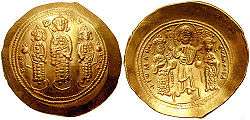Konstantios Doukas
| Konstantios Doukas | |
|---|---|
| Co-emperor of the Byzantine Empire | |
 Gold histamenon of Romanos IV: Michael VII flanked by his brothers Andronikos and Konstantios on the obverse, Romanos IV and Eudokia Makrembolitissa crowned by Christ on the reverse | |
| Reign | 1060–1078 |
| Predecessor | Michael VII |
| Successor | Nikephoros III Botaneiates |
| Born | 1060 |
| Died | 1082 |
| Dynasty | Doukid dynasty |
| Father | Constantine X |
| Mother | Eudokia Makrembolitissa |
Konstantios Doukas (Greek: Κωνστάντιος Δούκας, 1060–1082), Latinized as Constantius Ducas, was the son of Byzantine Emperor Constantine X Doukas and younger brother of Byzantine Emperor Michael VII Doukas. He reigned as junior co-emperor from his birth, but was unable to establish himself as sole emperor against Nikephoros III when Michael VII abdicated in 1078.
Career
Konstantios was the youngest son of Constantine X Doukas and was born a porphyrogennetos. Upon his birth he was made co-emperor,[1] alongside his brother Michael VII Doukas. His other brother, Andronikos Doukas, was also elevated some eight years later.[1] He retained the imperial title during the reigns of Romanos IV Diogenes and his elder brother, Michael VII, as senior emperors. In 1078, when Michael's reign came to an end by an insurrection at Constantinople, he abdicated in favour of Konstantios,[1] as Andronikos had apparently died a year or two before. His only rival was Nikephoros III, who was on his way to Constantinople when news arrived of Michael's overthrow.[2]
It was soon manifestly evident that Konstantios was completely incapable of leading the empire.[1] Although the troops in Asia Minor also proclaimed him emperor, his incapacity was soon so evident that his own supporters swiftly delivered him to Nikephoros III, who forced him to become a monk, taking up his residence on one of the Princes Islands in the Propontis.[3]
By 1081, he was recalled into active service by Alexios I Komnenos, who had married into the Doukas family. Sent to the war against the Normans, he perished while fighting them at Dyrrhachium in 1082.[1]
References
- Canduci, Alexander (2010), Triumph & Tragedy: The Rise and Fall of Rome's Immortal Emperors, Pier 9, ISBN 978-1-74196-598-8
- Kazhdan, Alexander, ed. (1991), Oxford Dictionary of Byzantium, Oxford University Press, ISBN 978-0-19-504652-6
- Polemis, Demetrios I. (1968), The Doukai: A Contribution to Byzantine Prosopography, London: Athlone Press
- George Finlay, History of the Byzantine and Greek Empires from 1057–1453, Volume 2, William Blackwood & Sons, 1854
- Skoulatos, Basile (1980), Les personnages byzantins de I'Alexiade: Analyse prosopographique et synthese (in French), Louvain: Nauwelaerts